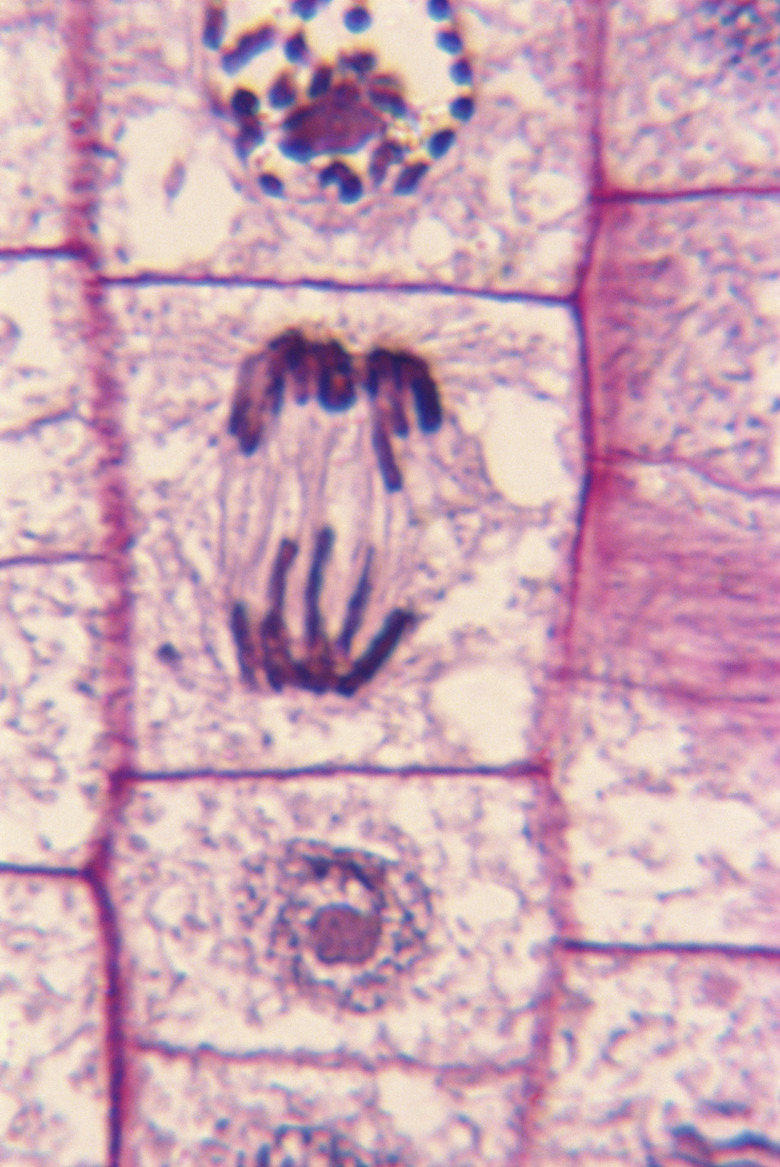Roles Of Cell Organelles In Mitosis
For the cell to live on and divide, organelles must be team players and work together with impeccable timing. Each organelle has an assigned job that contributes to cell stability and DNA replication through mitosis. Key organelles that make mitosis go as planned include the nucleus, mitotic spindle and microtubules. Checkpoints during the cell cycle help correct errors and prevent serious problems such as chromosome abnormalities.
What’s an Organelle?
What's an Organelle?
Organelles are visible parts of a cell with an assigned task that must be done at the right time in the right way. Organelles in a cell serve some of the same purposes as organs in the body of animals and human beings. A membrane encases many – but not all – types of organelles. The organelles involved in mitosis differ somewhat between plant and animal cells.
Mitosis and Organelles
Mitosis and Organelles
Mitosis is a beautifully orchestrated division of genetic material in DNA directed by the nucleus, a large and influential organelle of the cell. Plant and animal cells repeatedly undergo mitosis to grow and rejuvenate tissues. Organelles involved in cell division must adroitly play their part. Mistakes made by organelles during mitosis can halt division or disrupt normal chromosome division and impair gene functioning in the cell or organism if the cell is allowed to proliferate.
Read more about the structure and function of the nucleus.
Lots of action occurs in the nucleus of a cell preparing for the process of mitosis. Once nutrients are available and proteins duplicated, the nuclear envelope disintegrates, allowing chromosomes to spill into the cytoplasm. The true marvel of mitosis happens when sister chromatids line up in the middle of the cell, helped along by the mitotic apparatus. From there, the chromosomes will be guided to opposite poles where new nuclei will form before cells separate during cytokinesis.
Read more about the steps and facts of mitosis.
Organelles Involved in Cell Division
Organelles Involved in Cell Division
The nucleus is a like a locked safe where all instructions for cell growth are stored in the form of RNA and chromatin. In preparation for mitosis, genetic material increases in the nucleus. When mitosis starts, chromosomes condense, and the nuclear envelope around the nucleus disintegrates to free the chromosomes. The nuclear envelope reforms around the chromosomes after cell division, and the chromosomes return to the nucleus in anticipation of another cell cycle.
Microtubules are hollow, tubular proteins in the cell's cytoskeleton that can expand and contract quickly depending on the cell's needs. Microtubules work in tandem with motor proteins. As part of the spindle apparatus, microtubules help position, separate and pull apart chromosomes when the cell divides during mitosis.
When a cell prepares to make a copy of itself, cylindrical-shaped centrioles leave their post by the nucleus and head to opposite poles of the cell. Centrioles are microtubules that push out stringy fibers in a circular fashion, creating the appearance of a flowering aster. Centrioles in animals are thought to have a role in aligning and separating chromosomes; however, their function isn't entirely clear since plant cells lack centrioles but still form spindle fibers.
Mitosis: Organelles in Animals
Mitosis: Organelles in Animals
Mitosis is involved in cell division in animal cells to replace worn-out cells and heal injured tissue. Normal cell growth is achieved through the process of mitosis. Reproduction in multicellular animals is achieved through meiosis, a process of cell division that involves an exchange of genes between chromosomes before cell division. In animal cells, the plasma membrane pinches around the middle of the cells and cleaves them apart.
Mitosis: Organelles in Plants
Mitosis: Organelles in Plants
Plant organelles involved in cell division share a number of similarities. However, plants are able to undergo mitosis without the presence of centrioles. Plant cells separate by forming a cell plate that is fused by vesicles released by the Golgi apparatus. Plants are immobile, and cells don't move when dividing, which differs from animal cell membranes that elongate in cytokinesis.
Cite This Article
MLA
Dowd, Mary. "Roles Of Cell Organelles In Mitosis" sciencing.com, https://www.sciencing.com/roles-cell-organelles-mitosis-22199/. 30 July 2019.
APA
Dowd, Mary. (2019, July 30). Roles Of Cell Organelles In Mitosis. sciencing.com. Retrieved from https://www.sciencing.com/roles-cell-organelles-mitosis-22199/
Chicago
Dowd, Mary. Roles Of Cell Organelles In Mitosis last modified August 30, 2022. https://www.sciencing.com/roles-cell-organelles-mitosis-22199/
